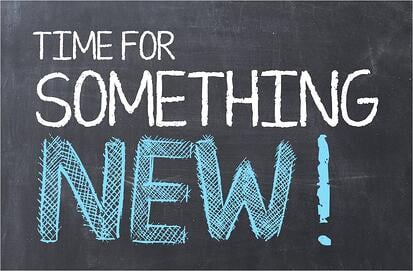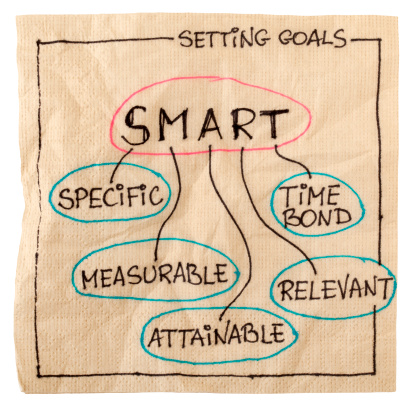 You are scrolling through social media for entertainment and inspiration, and you see the person you want to be like. They are fit, energetic, happy, and have been consistent with their workouts for years now. Maybe you’ve been exercising on and off for a while but can’t find the routine that you can stick to. Well, it’s a new year, so… “New year, new plan!”
You are scrolling through social media for entertainment and inspiration, and you see the person you want to be like. They are fit, energetic, happy, and have been consistent with their workouts for years now. Maybe you’ve been exercising on and off for a while but can’t find the routine that you can stick to. Well, it’s a new year, so… “New year, new plan!”
The first step is determining your SMART goal:
S: Specific – A specific goal adds clarity to a broad statement. “I want to be fit” is a great goal, but the specific goal needs to add depth to what being fit means to you. “I want to improve my muscular strength” is more specific and leads us into the next letter…
M: Measurable – You need to be able to measure your progress. For the previous example, you can use a one rep max to test muscular strength and easily measure before, during, and after results.
A: Attainable – Make sure you are honest with yourself. Your goal needs to be challenging, but doable. Is gaining muscular strength attainable if you only go to the gym once every other week? Probably not. But it would be if you know you can commit to lifting three times per week.
R: Realistic – Similar to the attainable aspect, you need to know yourself when setting goals. Can you realistically set aside one hour a few times per week? Are you realistically going to go to the gym at 5am?
T: Time-Sensitive – If a goal doesn’t have a start and end point, it’s hard to measure progress or ever feel like the goal is complete. Pick a duration that makes sense to you and then add that to the calendar.
Sticking with the example, your goal could look something like this: I want to improve my muscular strength to feel more fit. I’m going to go to the gym at 5am three days per week for 8-weeks.
So, now that you have your smart goal, how do you stick with it?
Tip #1: Accountability Partner
Exercise with your spouse, friend, or a personal trainer. If you commit to a plan with them, you are more likely to follow through. You get the additional benefits of social wellness and can improve your mental health as well. I can vouch for this one. I have been trying for a while to find a routine to stick with. Who knew that all I needed was a workout partner for my 5:30am swims!
Tip #2: Plan & Prep Ahead
Whether you goal is to exercise in the morning, afternoon, or evening, you can make a commit to tomorrow’s workout by setting out your clothes and gear the night before. Additionally, have an idea of your meals and/or snacks to make sure you are getting the nutrition your body needs when it needs it. Gym bag packed – check. Water bottle filled – check. Alarm set – check. Determination – check.
Tip #3: Mini Goals & Celebrations
It is quite helpful to celebrate small wins along the way. Was it hard for you to wake up early for your first ever morning workout? Then set a mini goal to wake up early three times this week. If you can do that, you will buy those colorful running shoes you’ve been wanting. A celebration should make you feel accomplished but try to celebrate in a way that does not deter you from your end goal. Yes, waking up is tough, but no, your celebration shouldn’t be an extra day off of exercise.
I hope you are eager to set a SMART goal and start working hard on what really matters to you. This is your year. The time is now! Are you ready to commit?




 March is National Nutrition Month! It may be time to revisit and reestablish your New Year’s diet resolutions. I wanted to pass along a basic guide to healthy eating and lifestyle habits that can also be used for weight loss.
March is National Nutrition Month! It may be time to revisit and reestablish your New Year’s diet resolutions. I wanted to pass along a basic guide to healthy eating and lifestyle habits that can also be used for weight loss. 
 As you kick off the New Year in your workplace, you will probably overhear many of your employees talking about being healthier this year, and their New Year’s resolutions. Eating better, participating in more physical activity, stressing less, establishing a better work-life balance… the list goes on. If your workforce is like the majority of people who have the best intentions of improving their health this year, many will be unsuccessful once work and life get back in the way.
As you kick off the New Year in your workplace, you will probably overhear many of your employees talking about being healthier this year, and their New Year’s resolutions. Eating better, participating in more physical activity, stressing less, establishing a better work-life balance… the list goes on. If your workforce is like the majority of people who have the best intentions of improving their health this year, many will be unsuccessful once work and life get back in the way. 
 Here are some ideas to consider for the New Year:
Here are some ideas to consider for the New Year:
 First and foremost, let’s make some things clear about resolutions. When you make a resolution, you have to remember that it is not just a commitment for January 1; it is for 365 days. Make sure from the beginning it is something that is a long-term goal and a change you want to see. If it is something you have repeatedly tried to do each year, it may be time to reevaluate and come up with a different strategy this year. Otherwise, you will set yourself up to fail.
First and foremost, let’s make some things clear about resolutions. When you make a resolution, you have to remember that it is not just a commitment for January 1; it is for 365 days. Make sure from the beginning it is something that is a long-term goal and a change you want to see. If it is something you have repeatedly tried to do each year, it may be time to reevaluate and come up with a different strategy this year. Otherwise, you will set yourself up to fail.
 By June 2013 only 46% of people will still be sticking to the resolutions they vowed to keep as the ball dropped and we said goodbye to 2012. A recent study showed that the three most popular resolutions are finding more family and friend time, increasing or starting an exercise program, and trying to lose weight. The tips below will help you stick to those resolutions so they will last all year long.
By June 2013 only 46% of people will still be sticking to the resolutions they vowed to keep as the ball dropped and we said goodbye to 2012. A recent study showed that the three most popular resolutions are finding more family and friend time, increasing or starting an exercise program, and trying to lose weight. The tips below will help you stick to those resolutions so they will last all year long. Another new year is here, and with that come high fitness expectations that your corporate wellness participants place upon themselves. When members come to us with New Year’s resolutions, our first step is to teach them how to set appropriate goals that will lead to success. Once you have the general picture of what your clients are hoping to achieve as well as why it’s important to them, you can help in fine-tuning their goals.
Another new year is here, and with that come high fitness expectations that your corporate wellness participants place upon themselves. When members come to us with New Year’s resolutions, our first step is to teach them how to set appropriate goals that will lead to success. Once you have the general picture of what your clients are hoping to achieve as well as why it’s important to them, you can help in fine-tuning their goals.